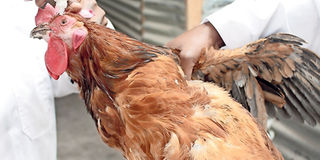Poultry vaccines 101

For ocular administration of vaccination in poultry, the vaccine should be dissolved in saline solution of 40ml per 1,000 doses and administered by means of a standardised dropper putting the vaccine into the open eye of the birds.
What you need to know:
- Chicken vaccines mostly come in two forms.
- Disease prevalence in most cases is not only dependent on hygiene, but also on climatic conditions, which may be beyond your control
- What diseases to vaccinate against and their respective schedules are highly dependent on your local conditions, prevalence and severity.
- Fowl pox vaccine is administered via the wing stab route using two hypodermic needles.
Biosecurity is important in poultry production systems because it enables you to prevent the introduction of infectious disease agents to your flock.
Effective control of diseases is obtained through vaccination, combined with proper hygiene practices. Vaccination is considered crucial because of its high contribution towards prevention of flock and production loss.
What is vaccination?
Vaccination is the introduction of a foreign body (antigen – derived from a disease-causing pathogen) to stimulate the immune system to develop protective immunity against that pathogen.
Chicken vaccines mostly come in two forms: Live or inactivated. The live vaccines are developed from weakened forms of pathogens causing the disease while inactivated ones are developed from killed form of pathogens causing the disease.
Live vaccines offer strong and long-lasting immunity and may require to be done once. Inactivated vaccines may be repeated several times for better immunity.
Why vaccinate?
Disease prevalence in most cases is not only dependent on hygiene, but also on climatic conditions, which may be beyond your control.
This is common during dry conditions or the rainy season that has just started when the severity and spread of diseases is high.
Always look at the cost-benefit ratio associated with vaccination taking into account the risk of infection and financial loss from diseases.
When and how to vaccinate
Vaccines that can be administered through drinking water or aerosol spray are commonly preferred, especially if dealing with large flock sizes and the ease of administration.
However, without proper monitoring of the birds especially for drinking water, vaccination may not be effective. Other methods such as ocular and nasal routes are effective because each bird is attended to individually.
However, they are labour-intensive. Vaccine injection via intra-muscular, intra-venous or sub-cutaneous routes is also common.
However, given the level of skills required to effectively administer the vaccine without causing injury, it is often advisable to contact your nearest vet or extension officer for assistance.
What diseases to vaccinate against and their respective schedules are highly dependent on your local conditions, prevalence and severity.
Here is a brief guide on the vaccination schedules of diseases and the most convenient procedures at farm level.
1. Mareks’ disease: Vaccination is done at the hatchery level on day-old chicks. The aerosol spray method is used and vaccination is done once since it provides a life-long immunity.
2. New Castle Disease (NCD): Vaccination is done at farm level on the first week of the chick’s life and later followed by a second vaccination on the third week to boost the first vaccination.
Live attenuated and inactivated forms of NCD vaccines are available in the market. NCD vaccine is administered orally via drinking water.
This involves withdrawal of drinking water for at least three hours prior to vaccination to stimulate dehydration. Mix the vaccine using water free of chlorine and detergents.
Ensure all birds have access to the medicated drinking water within two hours. The vaccine is packaged as 200-dose, 500-dose or 1,000-dose vials.
3. Gumboro (IBD): Vaccination is done at farm level on the second week of the chick’s life and later followed by a second vaccination on the fourth week to boost the first vaccination.
Vaccine may be administered through drinking water or the ocular route. The drinking water procedure is similar to that of NCD vaccine.
For ocular route, the vaccine should be dissolved in saline solution of 40ml per 1,000 doses and administered by means of a standardised dropper.
Administer one drop (0.04ml) of vaccine into the open eye of each bird. The vaccine is packaged as 200-dose, 500-dose or 1,000-dose vials.
4. Fowl typhoid: Vaccination is done at farm level by week eight. It is available in an inactivated form, which is administered through intra-muscular injection.
This method requires a sterile needle and syringe (to avoid contamination) for vaccine injection in the thigh or breast muscles at the rate of 1 ml per bird.
Consider contacting your nearest vet or extension officer if unfamiliar with the procedure. The vaccine is packaged as 50-dose, 100-dose or 300-dose vials.
It is important to note that fowl typhoid can be treated in case of an outbreak. However, recovered birds tend to be carriers of the pathogens causing the disease resulting in recurrent outbreaks.
5. Fowl pox: Vaccination should be done by the age of week 16 but not when the birds are laying to prevent product contamination.
Freeze-dried live attenuated form of fowl pox vaccine is available in the market. The vaccine requires a diluent to be also purchased to re-hydrate the freeze-dried component.
Fowl pox vaccine is administered via the wing stab route using two hypodermic needles. This process involves reconstitution of the freeze-dried vaccine in the diluent (For 100-dose use 1 ml diluent).
Thereafter, dip your sterilised needles into the reconstituted vaccine and stab through the wing web above the elbow joint.
Seek help from your nearest vet if unfamiliar with the procedure. The vaccine is packaged in 100-dose vial and accompanied by a diluent.




